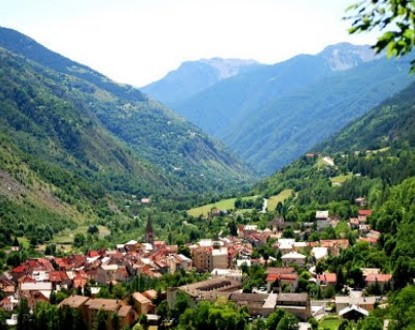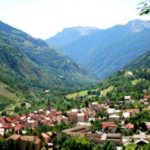Saint Etienne de Tinée, it is no longer the maritime climate. After the pass of Valabre and the Paule bridge, one enters the Alpine climate.

Our visit begins at the old gate of the village, where a stone bridge spans a tributary of the Tinée.
The 15th-century chapel of Saint Sebastian, by its position, protected the village from epidemics such as the plague and travelers from dangers. It is decorated with frescoes by Jean Canavesio and Jean Baleisoni. These two Italian artists are known for their frescoing skills, having completed the first at N D des Fontaines and the second at the church of Venanson.
Unusually, there are also frescoes on the outside, on the tympanum of the chapel. Inside, the walls, the vault, and the back of the altar are all decorated. These frescoes depict pages of holy history, including the Genesis with Adam and Eve. Although they are works of the quattrocento, you would be surprised by the expression on the faces, here there is expressionism.
This chapel conveys something indefinable, perhaps grace, but it transcends us. The Chapel of Saint Roch, a saint with similar virtues to Saint Sebastian, is a few steps away. It dates from the 17th century and is attached to a house.
That is its curiosity. The question of the chicken and the egg arises according to our guide. Saint Etienne had a convent of the Trinitarians, and today only the chapel remains. It is from the 17th century. It is where N D of the good remedy is invoked. It houses several paintings from the 17th and 18th centuries, as well as a larch wood altarpiece from 1737. Its 1685 frescoes are a type of ex-votos: healings, accidents, and even a scene from the Battle of Lepanto.
In the past, there were depictions of Saints John de Matha and Felix of Valois. They were covered as they were dilapidated in 1837, before the visit of Bishop Galvano of Nice. These two saints founded the Trinitarian Order, to redeem captives from the Barbary pirates. The medieval parish church was under the protection of Saint James the Greater.
Only the gothic apse with its ribs above the altar and its Lombard bell tower remain of it. The latter is the oldest monument in the village. It would date back to before the Dédition of 1388, having the Fleur-de-Lys of France engraved on one of its stones. Two other dates provide historical markers on this building: 1492 and 1659. Originally, it did not have its octagonal spire and served as a watchtower. Today’s church is of the Romano-Byzantine style and was completed on December 4, 1789.
The Chapel of Saint Maur is from the 16th century. It is located on the mule path leading to the Auron plateau. Its frescoes are attributed to Andreade Cella. They portray the lives of Saint Sebastian and Saint Maur. Saint Erige at Auron is a Templar chapel from the 13th century.
In the Middle Ages, it was inhabited by shepherds and the people of Saint Etienne who came there for haymaking and harvesting. Saint Erige was prayed to for stillborn children, so he might resurrect them temporarily to anoint or baptize them. Erige was the Bishop of Gap and died in 603. Legend tells that, upon returning from Rome to escape bandits, his horse leaped over the valley and landed on this plateau. The frescoes of Saint Erige date from 1451. They are among the most beautiful in the Nice region, narrating the lives of two saints: Erige and Denis, who was converted by Saint Paul.
Saint Mary Magdalene is also depicted here, as well as in the chapel of Saint Sebastian. In the Middle Ages, frescoes were the means of transmitting faith to illiterate populations.
Through images, akin to “comic books,” priests instructed the people. To conclude this visit, mention should be made of the book by Mireille Rovery “Mon clocher raconte,” a native of Saint Etienne passionate about its chapels.



